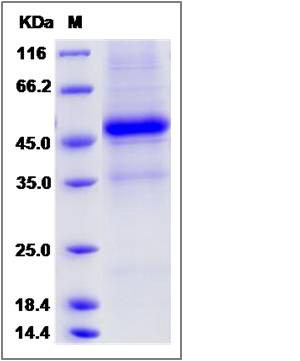Rat Interleukin 25 / IL25 / IL17E Protein (Fc Tag)
IL25
- 100ug (NPP3070) Please inquiry
| Catalog Number | P80194-R01H |
|---|---|
| Organism Species | Rat |
| Host | Human Cells |
| Synonyms | IL25 |
| Molecular Weight | The recombinant rat IL25 comprises 413 amino acids and predicts a molecular mass of 46.1 kDa. The apparent molecular mass of the recombinant protein is approximately 49 kDa in SDS-PAGE under reducing conditions due to glycosylation. |
| predicted N | Glu |
| SDS-PAGE |  |
| Purity | > 85 % as determined by SDS-PAGE |
| Protein Construction | A DNA sequence encoding the rat IL25 (D3ZLB1) (Val17-Ala169) was expressed, fused with Fc region of human IgG1 at the N-terminus. |
| Bio-activity | Measured by its binding ability in a functional ELISA. Immobilized mouse IL17BR-His (P51109-M08H) at 10 μg/mL (100 μl/well) can bind rat Fc-IL25 (P80194-R01H). The EC50 of rat Fc-IL25 is 0.12-0.27 μg/mL. |
| Research Area | Cancer |Invasion microenvironment |Angiogenesis |Cytokines / Chemokines in Angiogenesis |Interleukins |
| Formulation | Lyophilized from sterile PBS, pH 7.4 1. Normally 5 % - 8 % trehalose, mannitol and 0.01% Tween80 are added as protectants before lyophilization. Specific concentrations are included in the hardcopy of COA. |
| Background | Interleukin-25 (IL-25) is a cytokine that shares sequence similarity with interleukin 17. This cytokine can induce NF-kappaB activation, and stimulate the production of interleukin 8. Both this cytokine and interleukin 17B are ligands for the cytokine receptor IL17BR. IL-25 is a member of the IL-17 family of cytokines. However, unlike the other members of this family, IL-25 promotes T helper (Th) 2 responses. IL-25 also regulates the development of autoimmune inflammation mediated by IL-17–producing T cells. IL-25 and IL-17, being members of the same cytokine family, play opposing roles in the pathogenesis of organ-specific autoimmunity. IL-25 promotes cell expansion and Th2 cytokine production when Th2 central memory cells are stimulated with thymic stromal lymphopoietin (TSLP)–activated dendritic cells (DCs), homeostatic cytokines, or T cell receptor for antigen triggering. Elevated expression of IL-25 and IL-25R transcripts was observed in asthmatic lung tissues and atopic dermatitis skin lesions, linking their possible roles with exacerbated allergic disorders. A plausible explanation that IL-25 produced by innate effector eosinophils and basophils may augment the allergic inflammation by enhancing the maintenance and functions of adaptive Th2 memory cells had been provided. |
| Reference |
